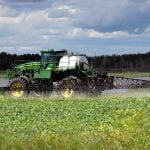MOOSE JAW – Calculating the cost of implementing rotational grazing in riparian areas is one thing.
Calculating the benefits is another.
Etienne Soulodre, rangeland agrologist with the Saskatchewan Watershed Authority, said there are few hard numbers on the benefits.
“Environmental valuation is a pretty green science,” he told the recent Moose Jaw River Watershed Stewards Inc. livestock conference.
Soulodre said a study has found a wide range of costs associated with riparian grazing. The average cost for infrastructure is about $7,000 per kilometre of stream.
Read Also

VIDEO: Green Lightning and Nytro Ag win sustainability innovation award
Nytro Ag Corp and Green Lightning recieved an innovation award at Ag in Motion 2025 for the Green Lightning Nitrogen Machine, which converts atmospheric nitrogen into a plant-usable form.
That investment would include water site development, fencing and pasture improvements.
Producers have to be able to justify that cost, he said.
Economists have simulated improvements in forage production on a hypothetical ranch at Claresholm, Alta., and found that if riparian areas cover at least seven percent of the grazing area, then it pays to invest in some infrastructure to better manage the area.
“If you get more forage production, that’s where the guy can make some money,” Soulodre said.
The response to extra fencing will pay for itself, he said.
A survey of 346 producers in Western Canada who had implemented riparian management rotational grazing found higher weight gains in their cattle, better quality forage and environmental benefits, Soulodre said.
In Saskatchewan, there are 80,000 kilometres, or 50,000 miles, of stream. Cattle graze along about 40 percent of that riparian area.
Soulodre said about 20 percent of the province’s riparian areas are considered healthy.
So, if 80 percent needs improving, at $7,000 per km, the cost is high.
Farmers may not be able or need to undertake all that work but there are environmental benefits to society at large from cleaner water and wildlife habitat. The question is whether people are willing to pay for those benefits.
“A random survey of 300 people found clean water and wildlife habitat provided by good riparian management is worth about $21 million,” Soulodre said.
Another study tried to calculate the economic value of improving water, soil and wildlife habitat. It looked at just one mile of stream in one operation and estimated the improvements’ value to society at $13,000.
Multiplying that preliminary number by the total 80,000 km of stream indicates a value of about $650 million.
“There is a public good out there,” Soulodre said. “We’re trying to figure out how large that is.”
The Lower Souris Watershed Committee in the southeastern part of Saskatchewan is undertaking a two-year ecological goods and services pilot project with 150 producers helping that process.















